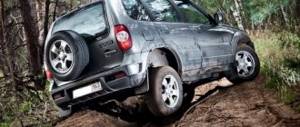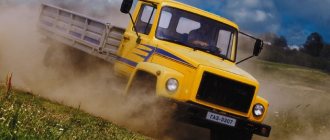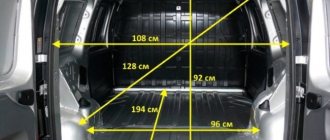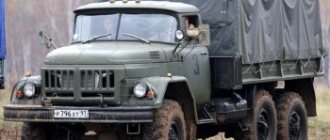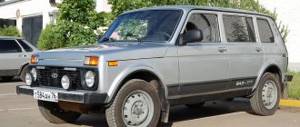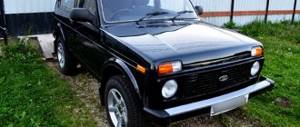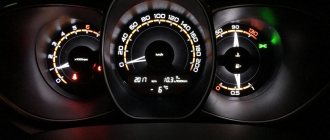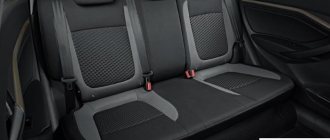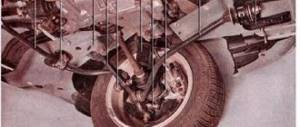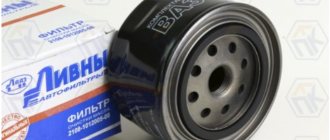07 October 2015 Lada.Online 106 149 19
Even at the stages of car development, it was known that the Vesta platform would be truly new, and not just another modernization of the VAZ 2108 suspension. Now that serial production of the sedan has already started, and the first samples have already been on test drives in various car magazines, more detailed details are being clarified about the chassis of the Lada Vesta.
The last adjustments to the suspension characteristics took place in winter in Spain, at the IDIADA training ground. Then a balance was found between comfort and car controllability. What happened?
Lada Vesta front suspension design
The supporting structure is based on a subframe, which is an innovation for the domestic automobile industry. Also, for the first time, the L-shaped levers were used.
The subframe performs the additional function of strengthening the body, giving it strength, and preventing deformation on uneven surfaces. As a result, the overall safety score was increased by five points.
In general, the suspension design is quite simple and in many ways similar to Renault Logan and Renault Duster of the second generation. Carrying out preventive maintenance does not require additional costs. The steering gear is now secured to the bottom of the engine compartment.
Independent suspension
From a physical point of view, the “low” position of the rack provides maximum connection with the steering knuckle. An electric amplifier is pre-installed on the rail, which was not previously in the design of VAZs. The shape of the transverse stabilizer has been redesigned to improve the “feel” when turning the steering wheel. The castor (tilt) angle is 5°, independent suspension, MacPherson struts, which together make the car smoother.
Revolution is ahead
The largest number of revolutionary innovations for VAZ were applied to the front suspension. First of all, this is a change in the concept of its architecture. For the first time on Lada cars, the front suspension is mounted on a subframe, which will increase its rigidity and geometry accuracy while simultaneously increasing vibration-acoustic characteristics.
No less revolutionary is the location of the steering rack, which has moved downwards, which eliminates the need to turn the wheels through levers - now the rods are connected directly to the hubs. This approach will significantly improve the car's handling characteristics, bringing them to the European level, which has been expected from VAZ products for several decades. Of the usual elements, only the electric power steering remains, which will be mounted on the steering column to simplify the design.
The Lada Vesta has a completely independent front suspension, with a castor angle of five degrees. MacPherson struts and L-shaped arms of our own design are used. Russian engineers also introduced a new stabilizer, which received a different shape, elongated struts and a different metal composition. The result is a much more sensitive system, which contributes to improved clarity and smoothness of control, as well as the behavior of the sedan on the road.
Despite the new layout, the developers managed to maintain an acceptable ground clearance (ground clearance) for Vesta, which for the sedan is 185 mm from the ground to the engine crankcase protection.
This means that the new product will feel quite confident on Russian roads. As for other figures, the wheelbase of the Lada Vesta is 2635 mm, the front wheel track is 1510 mm, and the distance between the rear wheels is exactly the same.
Rear suspension device
The food is borrowed from the French brand Renault Logan of the second generation. The design is typical - a transverse metal beam with springs spaced on the sides.
The brake system is of a drum type, which was expected, since disc mechanisms would increase the cost of the model by 3 - 4%. In general, the “drums” do an excellent job of the task at low and medium speeds.
Design (diagram):
- Levers.
- Gaskets for springs.
- Upper support.
- Compression buffer.
- Gas shock absorber.
- Hub axis.
- Brake drum.
- The wheelbase is extended to 1510 mm.
What's new: about built-in technologies and stabilization system
In addition to the above innovations, we additionally note the presence of systems:
- ABS;
- ESP;
- EBD;
- electric power steering wheel from the Japanese concern Nissan;
- braking system from French Renault.
The stabilization system controls the vehicle's traction, which makes it easy to overcome various drifts and obstacles while driving.
You can significantly improve the vehicle's maneuverability by simulating a differential lock. In Lada Vesta such a system is configured very effectively. Now the car is not “afraid” of dirt, bumps, or wet roadsides. When the mode is activated, the electronics enter the “all-terrain” phase. It is not recommended to use this mode on an ongoing basis.
What are the advantages of the new Lada Vesta suspension?
- The suspension concept has been radically changed. The supporting structure is based on a subframe at the bottom of the engine compartment;
- increased rigidity;
- compliance of body geometry with standards;
- improvement of vibro-acoustic properties;
- steering rods are directly connected to the hubs;
- castor (tilt) angle is 5°;
- MacPherson struts;
- upgraded anti-roll bar;
- maximum adaptation for domestic roads.
Conclusion
The average resource of the front and rear suspension of a car is designed for 90,000 km and above. If you follow the manufacturer's recommendations, take care of the equipment, and moderate speed conditions, the replacement interval for parts can be increased to 120 - 130 thousand km.
Carry out preventive work at certified service stations, where they provide a guarantee. If you have experience, practice repairs yourself, but this should not conflict with the requirements of the warranty. Buy spare parts mainly from domestic manufacturers. The quality of the components is not inferior to foreign analogues, and the price is 25–30% cheaper.
Knocks and noises in the front suspension
Even an amateur can recognize extraneous noises that appear in his own car, because an unfamiliar sound is always clearly audible against the background of the familiar “ensemble.” Knocks and noises in the chassis of the car should not plunge the owner into a state of shock, because all components are repairable, but it is necessary to urgently diagnose and fix problems, since the condition of the suspension is not only driving comfort, but also road safety.
Extraneous noise can be produced by rubber with a hard tread or with a broken cord. A wheel bearing that has become unusable has similar symptoms. During the off-season, the accumulated dirt that gets between the brake disc and pads disturbs the ears.
Knocks have a different nature and appear in different situations. The cause of such an unpleasant phenomenon may be a faulty stabilizer link or bushing, a failed ball joint or support bearing. Let us examine in detail the diagnostic methods and methods for troubleshooting the suspension of the Lada Vesta.
Wheel bearing noise
If an inexperienced driver does not notice such a malfunction immediately, then over time he will still have to think about diagnostics, since this noise increases all the time.
In particularly advanced cases, the whine of the bearing can be heard in the cabin and can drown out other sounds.
Diagnostics
In order to make sure that the bearing is faulty, and at the same time determine from which side the sound is coming, it is enough to accelerate on the highway to 50 km/h, make sure that there are no other road users in front or behind, and make oscillating movements of small amplitude with the steering wheel while steering the car then to the right, then to the left.
This is interesting: Features of the suspension of the Lada Vesta sedan
If the sound dies down in one position of the steering wheel, and intensifies in another, then it’s definitely a bearing. Moreover, an increase in sound when turning to the right indicates a malfunction of the left bearing and vice versa. All that remains is to verify the assumption. To do this, hang the wheel on which suspicion falls. When it rotates, a noise is heard - change the bearing.
Repair
The bearing cannot be repaired and requires replacement. All necessary manipulations are spelled out in the repair manual. The work is complicated by the fact that special devices and tools are required to press out and press in the bearing.
Stabilizer link knock
No matter how expensive the car is, you need to come to terms with the fact that on our roads the anti-roll bar turns into a consumable item.
After several thousand kilometers, you can distinguish a characteristic knocking sound that sounds in the body. Diagnostics
The first sign of a malfunction is the appearance of knocking noises, usually not very strong, but radiating to the underbody. This is especially unpleasant when the car overcomes even the slightest obstacles. For an accurate diagnosis, you will have to take the lever and, resting it on the subframe, swing the stabilizer. If play is detected in the area of the upper or lower hinge of the strut and a tapping sound is heard, then the strut is out of order.
Repair
The service life of the racks is usually the same, so it is recommended to change them in pairs. Just change them, since they cannot be repaired. All that is needed to replace it is to load the stabilizer by hanging both wheels. Use a 16mm wrench to unscrew the nuts on the hinge pins, and keep them from turning with a 5mm hexagon.
Ball joint knock
At first glance, it is difficult to distinguish this knock from the knock of the struts described above. But this malfunction has its own characteristic features.
Diagnostics
The knocking noise from the ball joint increases when overcoming bumps with the wheels turned out. To verify that the ball joint is faulty, you need to hang the wheel and check for play when swinging it relative to the horizontal axis. In simple words, you need to grab the wheel at the top and bottom. But a more accurate result is obtained if you insert a pry bar between the lower suspension arm and the subframe. Having such a leverage, it is not difficult to detect play in the ball joint.
Repair
Service maintenance of this vehicle involves replacing the lower suspension arm assembly with a ball joint and two silent blocks. However, you can find such a unit on sale as a ball joint, so it is considered a non-repairable, but replaceable part.
To replace the ball for the first time, you will have to remove the lever, since these two parts are connected by rivets that will have to be drilled out. The work is complicated by the need to loosen the subframe. The new balls are bolted on, so replacing them again is easy.
This is interesting: Lada Vesta with independent suspension is a myth or reality?
Support bearing knock
Here you need to consider a whole range of symptoms of failure of the telescopic stand and its components. Many people mistakenly complain about shock absorber knocking. If we remember his structure, we can come to the conclusion that he himself cannot physically knock. It is represented by two cylinders, and a failed shock absorber does not dampen vibrations. But there is one nuance in the design of VAZ shock absorbers.
If a sudden and excessive force is applied during compression, the bypass valve system is deformed. In this case, fluid flows from one cylinder to another more slowly. When such a shock absorber operates at high frequencies, a slight play in the rod occurs, since there is less fluid under the piston than it should be. This play is audibly perceived as a knock.
Diagnostics
To determine the performance of the shock absorber, it is necessary to externally assess its condition. Liquid leaking out indicates the need to replace the unit. The second method is to rock the car in a vertical plane. It is necessary to achieve resonance and then stop the effort. The car should swing again, and the vibrations will stop. This means the shock absorber is working properly.
Diagnostics of the upper support and support bearing is carried out in three ways.
- The assistant must rock the car. If you put your hand on the support from the engine compartment, you can feel the play.
- The destruction of the bearing or support is observed when the rack is completely disassembled.
- Remove the steering knuckle from the strut. When rotating the strut together with the spring, you need to listen to the operation of the bearing. If a crunching sound is heard, the bearing or support must be replaced.
Repair
The telescopic stand is removed and disassembled according to the established regulations. All components can be replaced separately. Consumables: shock absorber, protective cover, damper, support bearing, bearing support.
Reviews
| № | Positive |
| 1. | Dmitry Vasilyevich , 43 years old (otzovik.com): the suspension is mounted on a subframe, a new form of levers, steering knuckles. Road obstacles are overcome without impact. |
| 2. | Arkady Semenovich , 39 years old (www.zr.ru): there are no complaints about the suspension at speeds up to 120 – 130 km/h, it works quickly and softly. At higher modes, there is a decrease in control efficiency, the car rolls when entering turns. |
| 3. | Kirill , 22 years old (autobann.su): control is sharp due to the fact that the rack is pre-installed on the subframe and has an indirect connection with the steering knuckles. |
| 4. | Matvey , 33 years old (lada-vesta.net): on previous modifications of the Lada, the chassis, suspension, and steering mechanism were worse. I can compare, since before the Lada Vesta there was a Priora and a Granta. |
| 5. | Vasily Petrovich , 43 years old (otzovik.com): my positive review of the chassis and suspension of the Lada Vesta. I've been using the car for three years now, no complaints. |
| 6. | Pyotr Semenovich , 45 years old (www.zr.ru): for me, as a resident of a rural area, you can’t find a better car. I'm happy with the purchase, no complaints. I fix minor breakdowns on my own without going to a service station. |
| 7. | Sergey , 20 years old (autobann.su): rear springs and shock absorbers have become softer compared to the Lada Granta. Minor unevenness is silently absorbed. For our imperfect roads, this is what we need. |
| 8. | Saveliy Petrovich , 43 years old (lada-vesta.net): the vehicle’s ground clearance allows it to overcome many obstacles without reducing speed, detours, or maneuvers. This is very good for city roads when the car follows the flow. |
| 9. | Dmitry , 30 years old (otzovik.com): my positive review of the Lada Vesta, there are no critical comments, and I fix minor breakdowns on my own. |
| 10. | Nikolai Petrovich , 43 years old (www.zr.ru): there are no comments on the components, I systematically carry out technical inspections, diagnostics, and treat equipment with care. The car is three years old, the condition of a new car. |
| 11. | Alexey , 35 years old (autobann.su): replaced the bushings in two years, checked the wheel alignment. I'm pleased with the build quality, my recommendations to motorists. |
| Negative | |
| 12. | Vitaly Nikolaevich , 43 years old (www.zr.ru): in the first year of service, replaced the chassis bushings. The shock absorbers began to leak and the springs began to creak. |
| 13. | Leonid , 27 years old (otzovik.com): after 35,000 km, replaced the standard stabilizer seals with polyurethane ones. The manufacturer saves on materials and installs the cheapest ones. |
| 14. | Arsen Mikhailovich , 45 years old (autobann.su): the model needs to be improved and defects eliminated. It’s better to wait a while or buy a second generation Renault Logan. |
Differences between the suspension of Lada Vesta SW and Lada Vesta SV Cross
The version with the Cross prefix differs not only in its external qualities, but also in its technical properties. Externally, the model looks strong and brutal. But driving performance does not always correspond to appearance. To justify the name of the model, the manufacturer decided to change some structural suspension components, but did not conduct experiments with the engine.
Front suspension of Lada Vesta Cross
The Vesta Cross suspension has slightly different shock absorbers. Here they are more rigid, although they belong to the same type. The sports version has longer and stiffer springs. The developers also made some manipulations with certain settings. Changes in parameters have increased the sharpness of response to steering wheel control, and its position is more clearly felt. During speed, after a maneuver, the car quickly returns to its previous control positions.
Lada Vesta is a great achievement of the domestic manufacturer. Due to structural changes, the vehicle received higher handling and safety characteristics. This was achieved through the use of various innovations.
